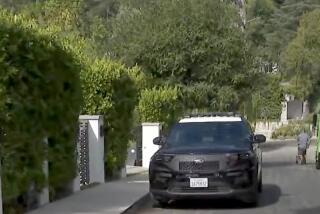Effectiveness of Roping Off Drug Areas Questioned
Police barricades thrown up this week to reduce drug traffic in a Sepulveda neighborhood have worked dramatically there, but they did so by pushing the narcotics trade into nearby areas, Los Angeles police officials conceded Friday.
As a result, police have stepped up enforcement efforts in areas to the west and south of the 12-square block Columbus Avenue neighborhood they barricaded Nov. 7. In one area just four blocks west of the barricaded zone, for example, more than 40 drug buyers were arrested in a two-day undercover sweep this week.
“It’s like pushing an air bubble around inside an air mattress--it changes location, but it doesn’t go away,” said Lt. Gary Rogness, who heads the Los Angeles Police Department’s narcotics field enforcement unit in the San Fernando Valley.
“But that doesn’t mean you don’t try to get rid of it.”
The increase in drug traffic in nearby areas has raised questions about the effectiveness of cordoning off neighborhoods to fight drug activity, a tactic that Los Angeles police were said to be the first to use on a large scale.
An aide to Councilman John Ferraro said the councilman wonders whether police will ultimately have to put “a Berlin Wall around Sepulveda” in order to stamp out drive-by drug traffic.
“We’re not opposed to the barricades, but I think the question in the council will be, ‘What have you accomplished if the dealers and buyers just move elsewhere?’ ” said Bill Gilson, Ferraro’s deputy.
Capt. Mark D. Stevens said police expected that closing Columbus Avenue would cause narcotics traffic to spill over into nearby areas, which already were active drug spots. Now, officers want to temporarily barricade the neighborhood to the west, but Stevens said it may be difficult because it contains two schools and a church.
“We’ve ferreted the dealers out of their holes and we’re going to keep after them,” said Stevens, adding that he believes drug dealers will not move into single-family neighborhoods to the north and east because they would be too visible there.
Stevens said he has increased patrols in surrounding Sepulveda areas, using a 10-officer task force that previously concentrated efforts in the Columbus Avenue neighborhood.
In addition, Rogness sent his special narcotics enforcement unit into Sepulveda neighborhoods surrounding the barricaded area for two days last week.
Police are urging the City Council to make permanent the barricades around the Columbus Avenue neighborhood. Under the proposal, apartment owners in the area would donate money to set up and staff a guard station at the corner of Sepulveda Boulevard and Rayen Street. City public works officials had no estimate Friday of how much the proposal would cost.
Six of the 15 council members said this week that they support the idea--and two said they were considering it--but some have reservations about the impact on nearby areas.
The plan is being lauded by apartment owners who say they are tired of grappling with the problem. “I’m for anything that helps keep (the area) clear of drug traffic,” said Guenter Pauly, owner of a six-unit building he fenced last year to keep drug dealers from using his parking lot.
Councilmen Joel Wachs, Ernani Bernardi, Hal Bernson, Mike Woo, Gloria Molina and Zev Yaroslavsky said they support the proposal. Yaroslavsky said that “nothing is more important than the peace of mind” of the Columbus Avenue residents, whose neighborhood has long been the most active drug-trafficking spot in the Valley, according to Rogness.
But the barricades have not contributed to the peace of mind of Teresa Guzman, a baby-sitter who lives west of the cordoned-off area.
She said friends living on Columbus Avenue tell her that the dealers have vanished. “They have all come over here,” Guzman said. “I wish they’d close the streets here too.”
More to Read
Sign up for Essential California
The most important California stories and recommendations in your inbox every morning.
You may occasionally receive promotional content from the Los Angeles Times.









